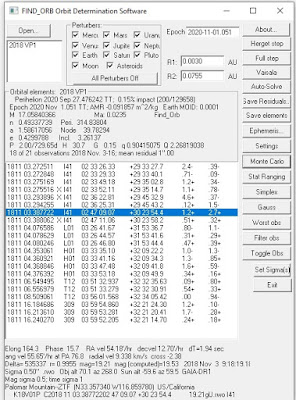On 2018-08-13 I check the
NEO Confirmation Page(NEOCP) and an object clalled
ZTF00Th.
I was able to obtain a set of 4-60 second luminance BIN2 images taken with
iTelescope.net's (T30) and a set 12-60 second luminance BIN2 images taken with
iTelescope.net's (
T30). I use
Astrometrica to do the
data reduction by way of the stack and track method. I had Astrometrica
stack 3 sets(stacks) of 3 images. Each image was shifted match movement
of
ZTF00Th.
 |
A confirmation image of the Mars-crossing Asteroid 2018 PO23
on 2018-08-13 from Siding Spring Observatory,
Coonabarabran, NSW, Australia. (MPC Q62)
a stack of 4-60 second luminance BIN2 images
taken with iTelescope.net's (T30)
Steven M. Tilley |
 |
A confirmation image of the Mars-crossing Asteroid 2018 PO23
on 2018-08-13 from Siding Spring Observatory,
Coonabarabran, NSW, Australia. (MPC Q62)
a stack of 4-60 second luminance BIN2 images
taken with iTelescope.net's (T30)
By Steven M. Tilley |
 |
A confirmation image of the Mars-crossing Asteroid 2018 PO23
on 2018-08-13 from Siding Spring Observatory,
Coonabarabran, NSW, Australia. (MPC Q62)
a stack of 4-60 second luminance BIN2 images
taken with iTelescope.net's (T30)
Steven M. Tilley |
 |
A confirmation image of the Mars-crossing Asteroid 2018 PO23
on 2018-08-13 from Siding Spring Observatory,
Coonabarabran, NSW, Australia. (MPC Q62)
a stack of 4-60 second luminance BIN2 images
taken with iTelescope.net's (T30)
By Steven M. Tilley |
Then I submitted this batch of 4 observation to the Minor Planet Center.
About 14 hours later I obtain a set of 60-60 second luminance BIN2 images taken with
iTelescope.net's(
T11) I had Astrometrica
stack 3 stacks of 15 images ( note a
star keep me from having 4 stacks of 15 images)
 |
A confirmation image of the Mars-crossing Asteroid 2018 PO23
on 2018-08-14 from from Mayhill,
New Mexico [New Mexico Skies](MPC Code H06)
a stack of 15-60 second luminance BIN2 images
taken with iTelescope.net's (T11)
By Steven M. Tilley |
 |
A confirmation image of the Mars-crossing Asteroid 2018 PO23
on 2018-08-14 from from Mayhill,
New Mexico [New Mexico Skies](MPC Code H06)
a stack of 15-60 second luminance BIN2 images
taken with iTelescope.net's (T11)
By Steven M. Tilley |
 |
A confirmation image of the Mars-crossing Asteroid 2018 PO23
on 2018-08-14 from from Mayhill,
New Mexico [New Mexico Skies](MPC Code H06)
a stack of 15-60 second luminance BIN2 images
taken with iTelescope.net's (T11)
By Steven M. Tilley |
Then I submitted this batch of 3 observation to the Minor Planet Center.
After another ten hours I obtain a set of 60-60 second luminance BIN2 images taken with
iTelescope.net's(
T17) I had Astrometrica
stack 3 stacks of 15 images ( note the first 9 images where on the "wrong" side of the meridian flip)
 |
A confirmation image of the Mars-crossing Asteroid 2018 PO23
on 2018-08-14 from Siding Spring Observatory,
Coonabarabran, NSW, Australia. (MPC Q62)
a stack of 15-60 second luminance BIN2 images
taken with iTelescope.net's (T17)
By Steven M. Tilley |
 |
A confirmation image of the Mars-crossing Asteroid 2018 PO23
on 2018-08-14 from Siding Spring Observatory,
Coonabarabran, NSW, Australia. (MPC Q62)
a stack of 15-60 second luminance BIN2 images
taken with iTelescope.net's (T17)
By Steven M. Tilley |
 |
A confirmation image of the Mars-crossing Asteroid 2018 PO23
on 2018-08-14 from Siding Spring Observatory,
Coonabarabran, NSW, Australia. (MPC Q62)
a stack of 15-60 second luminance BIN2 images
taken with iTelescope.net's (T17)
By Steven M. Tilley |
Then I submitted this batch of 3 observation to the Minor Planet Center.
After 110 observations, collectively made from 27 observatories from around the world, at
Aug. 16.90, 2018 the Minor Planet Center gave ZTF00Th. the
provisional designation 2018 PO23 and removed it form the NEOCP.






























































